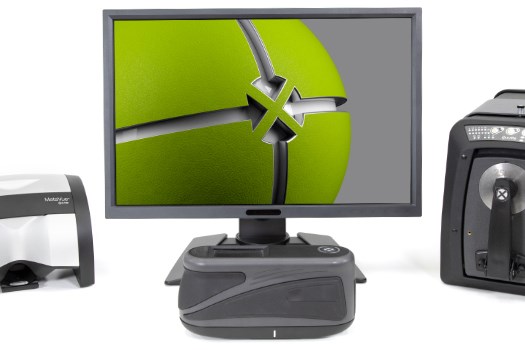Upgraded Software Enables Broader Use of Color & Appearance Data in Digital Design
X-Rite’s latest release of Pantora allows brands and suppliers to leverage their existing color data and measurement devices.
A new release of the Pantora desktop application for the management of color and appearance data in digital design and production workflows from X-Rite and Pantone, Grand Rapids, Mich., enables brands and suppliers to quickly capture such data using X-Rite spectrophotometers to render a digital material file for 3D design, production, and quality control teams.
Pantora now connects with the Ci7000 Series, MA-T12, and MetaVue VS3200 spectrophotometers allowing users to leverage their existing color data and measurement devices and to quickly capture or import spectral and appearance data into the application and create virtual material samples for plastics, paints, metals, fabrics, and meshes. Using Pantora, users can store, edit, and share digital material files using Appearance Exchange Format (AxF) files across product lifecycle management (PLM), CAD, and 3D rendering software.

The Pantora desktop application reportedly simplifies the management of a large volume of complex color and appearance data. It acts as the epicenter for appearance workflows connecting digital material capture sources with output destinations. Users can now import a measured material sample or connect to an X-Rite spectrophotometer to measure a physical sample directly into Pantora. The Ci7000 series of benchtop sphere spectrophotometers capture transmission of color on translucent materials and reflection color common in plastics. For paint and coatings samples, the MA-T12 multi-angle spectrophotometer can measure and virtualize flake texture and color flop. For multi-spectral texture measurements, the MetaVue VS3200 non-contact imaging spectrophotometer captures the texture of laminate, leather, and textile samples.
The Pantora Material Browser locates, acquires, and imports the digital material data as an AxF file that accounts for appearance attributes such as color, gloss, and texture. With the Material Viewer, companies can render the material in a virtual scene to see the effect of lighting, gloss levels, and special effect pigments. The new Pantora Variant Editor enables suppliers to create large digital material libraries by combining sample attributes.
Said appearance product portfolio manager Matthew Adby, “The ability to easily and affordably transform a physical material into a digital sample minimizes the need to ship samples around the globe between design teams, suppliers and partners. This allows companies to innovate and accelerate the design to manufacturing process. Using digital material virtualization, remote teams can continue to design and source materials using a 3D workflow while having confidence that material color and appearance will be accurate in production.”
Related Content
-
Injection Molder Changes Up Color Changes
An injection molder of trash cans, pallets, totes and other plus-size components, Rehrig Pacific’s machine fleet is composed of larger tonnage presses whose size makes material changes at the feed throat a potentially dizzying exercise.
-
Additive Masterbatches for Monomaterial PE Film Applications
Ampacet’s Biax4CE portfolio of additives and white color concentrates designed for MDO-PE and BOPE applications.
-
Reduce Downtime and Scrap in the Blown Film Industry
The blown film sector now benefits from a tailored solution developed by Chem-Trend to preserve integrity of the bubble.















